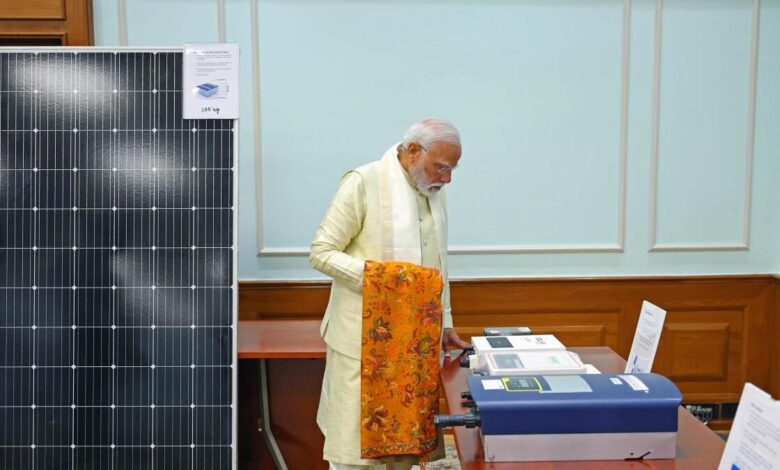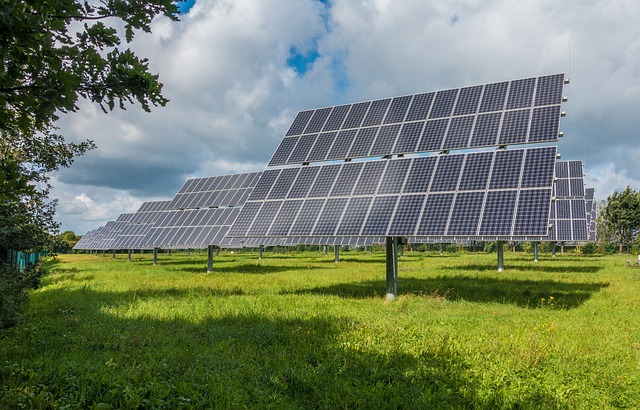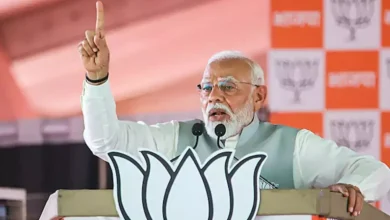PM Modi announces a new rooftop solar power scheme, to be installed in 1 crore homes
PM Modi said that the concept was inspired by Lord Ram and that it will not only benefit people but also make the nation self-sufficient in energy generation

Prime Minister Narendra Modi presented the Pradhanmantri Suryoday Yojana barely hours after returning from Ayodhya. Monday (January 22) was a momentous day for Prime Minister Narendra Modi. During the day, he watched over the consecration ceremony, popularly known as the pran pratishtha, of the Ram mandir at Ayodhya before announcing a massive project for the public.
In a post on X on Monday, Prime Minister Modi said, “The first decision I have taken after returning from Ayodhya is that our government will launch ‘Pradhanmantri Suryodaya Yojana’ with the target of installing rooftop solar on one crore houses.”
He went on to say that the concept was inspired by Lord Ram and that it will not only benefit people but also make the nation self-sufficient in energy generation.

Pradhan Mantri Suryodaya Yojana
On Monday, following his return from Ayodhya, Prime Minister Narendra Modi announced the Pradhanmantri Suryodaya Yojana, under which one crore families will receive solar roofs.
In a post on X, Modi said: “Today, on the auspicious occasion of the consecration of life in Ayodhya, my resolve has been further strengthened that people of India should have their own solar rooftop system on the roof of their houses. The first decision I have taken after returning from Ayodhya is that our government will launch ‘Pradhanmantri Suryodaya Yojana’ with target of installing rooftop solar on 1 crore houses.”
He went on to say that the initiative will not only assist the “poor and middle class” save money on their electricity bills, but would also help India achieve its objective of being energy self-sufficient.
The programme intends to offer power to low- and middle-income people via solar rooftop systems.
Furthermore, it will generate additional revenue from surplus power output.
Notably, the Pradhanmantri Suryodaya Yojana is quite similar to the previously announced Rooftop Solar Programme from 2014. The former project sought to generate 40,000 megawatts (MW), or 40 gigawatts (GW), of solar power by 2022.
This initiative was extended for four years in 2022, and it now seeks to build 4,000 megawatts (40 gigawatts) of rooftop solar capacity by March 2026. In fact, the Ministry of New and Renewable Energy announced that the Rooftop Solar Programme Phase-II has been extended until March 31, 2026, with no financial implications, within the originally approved total outlay of Rs 118.14 billion for both programme components – incentives to distribution companies and Central Financial Assistance to the residential sector.
How did this strategy work? Minister of New and Renewable Energy RK Singh had previously claimed that the user can pick any vendor on national platform and after installation, the subsidy is given immediately to bank account of the client.
India harnesses the sun’s power
At the end of last year, 2023, India’s solar power output was 73.31 GW, up from 63.3 GW in 2022. However, rooftop solar power output is only approximately 11.08 GW as of December 2023. According to data, Rajasthan generates the most solar electricity in the country, with 18.7 GW, followed by Gujarat with 10.5 GW. However, when it comes to rooftop solar electricity, Gujarat leads the way (2.8 GW), followed by Maharashtra (1.7 GW).
According to a paper published by JMK Research & Analysis and the Institute for Energy Economics and Financial Analysis, India, with over 300 million homes and 300 sunny days per year, offers enormous potential for rooftop solar systems in residential areas.Keeping this in mind, the government has launched several projects and initiatives. However, experts remark that, despite various steps, India’s rooftop solar power generation is not where it could be, and they provide explanations for why.
Neeraj Kuldeep, Senior Programme Lead at the Council on Energy, Environment, and Water, told Mongabay that one of the main reasons rooftop solar isn’t more popular is because it’s still too expensive for many people.
Interestingly, a survey found that in 2020, the average cost of a residential rooftop solar system in India was $658 per kilowatt. When compared to other major rooftop solar household markets like as Japan, the United Kingdom, Switzerland, and the United States of America, it is three to six times cheaper. Nonetheless, many individuals find it prohibitively expensive.
Kuldeep said that there is also a lack of awareness. Furthermore, users receive discounted power from electrical distribution corporations.
Why solar power is important in India
India values harnessing the sun’s power to create electricity for a variety of reasons. If India hopes to fulfil its goal of being net zero by 2070, it must look to the sun. In fact, during COP26 in November 2021, India committed to meeting 50% of its electricity needs through renewable energy sources by 2030. For these goals to be realised, India must harness the full potential of the sun. Furthermore, India’s share of global energy consumption is expected to quadruple to 11% by 2040, making it critical to improve energy security and self-sufficiency in power generation while minimising environmental costs. This rise in power consumption is anticipated to increase India’s reliance on coal, oil, and natural gas as sources of energy.
However, extra oil imports and expanded local coal output would not only fall short of energy needs, but will also have economic and environmental consequences.
Expansion of solar power plants and growing dependence on solar power helps India to boost energy security in the face of escalating demand.
Furthermore, India’s groundwater levels are already diminishing, necessitating a move away from water-based energy sources.
It remains to be seen if PM Modi’s new plan advances this objective.
You might also be interested in –PM Modi following “Yam rules” for 11 days leading to Ram Mandir Consecration



